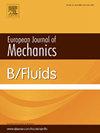基于多层感知器神经网络架构的不稳定大气表层流向湍流重构
IF 2.5
3区 工程技术
Q2 MECHANICS
引用次数: 0
摘要
如何准确模拟不同分层稳定性下的含沙湍流仍然是湍流研究中的一个关键挑战。本研究提出了一种利用多层感知器(MLP)神经网络结构重建不稳定大气表层(ASL)流向湍流的创新方法。该研究利用来自多个观测站点的三维风速和温度的高分辨率测量数据,建立了不稳定大气表层不同高度的流向风速预测模型。该预测模型综合了由 MLP 生成的大尺度运动(LSM)、由 Kaimal 频谱得出的小尺度运动(SSM)和平均风速,提供了湍流的综合表征。分析了含沙量和分层稳定性对模型性能的影响,重点讨论了弱不稳定性条件下模型的优势和局限性。通过跨站点比较、统计分析和功率谱评估进行了验证,证明该模型能够捕捉到含沙、不稳定 ASL 条件下风速的时间和频谱特征。研究还发现,在弱不稳定性条件下,剪切力主导着相干结构的形成,而浮力效应则会随着不稳定性的增加而加强垂直混合。与现有模型相比,所提出的预测模型适用于更广泛的条件,为研究大气含沙湍流提供了宝贵的数据来源,也为实际的防沙治沙工程提供了参考。本文章由计算机程序翻译,如有差异,请以英文原文为准。
Reconstruction of unstable atmospheric surface layer streamwise turbulence based on multi-layer perceptron neural network architecture
The accurate simulation of sand-laden turbulence under different stratification stabilities remains a critical challenge in turbulence research. This study presents an innovative approach to reconstructing streamwise turbulence in an unstable atmospheric surface layer (ASL) using a multi-layer perceptron (MLP) neural network architecture. Leveraging high-resolution measurements of three-dimensional wind velocity and temperature from multiple observational sites, the study develops prediction models for streamwise wind velocity at varying heights in the unstable ASL. The predictive model integrates large-scale motions (LSMs) generated by the MLP, small-scale motions (SSMs) derived from the Kaimal spectrum, and mean wind velocity, providing a comprehensive representation of turbulence. The impact of sand content and stratification stability on model performance is analyzed, with discussion highlighting the model's strengths and limitations under weak instability conditions. Validation is conducted through cross-site comparison, statistical analysis, and power spectrum assessment, demonstrating the model's ability to capture the temporal and spectral characteristics of wind velocity in sand-laden, unstable ASL conditions. The study also reveals that, under weak instability, shear forces dominate the formation of coherent structures, while buoyancy effects enhance vertical mixing as instability increases. Compared to existing models, the proposed prediction model is applicable over a broader range of conditions, offering a valuable data source for the study of atmospheric sand-laden turbulence and serving as a reference for practical sand control projects.
求助全文
通过发布文献求助,成功后即可免费获取论文全文。
去求助
来源期刊
CiteScore
5.90
自引率
3.80%
发文量
127
审稿时长
58 days
期刊介绍:
The European Journal of Mechanics - B/Fluids publishes papers in all fields of fluid mechanics. Although investigations in well-established areas are within the scope of the journal, recent developments and innovative ideas are particularly welcome. Theoretical, computational and experimental papers are equally welcome. Mathematical methods, be they deterministic or stochastic, analytical or numerical, will be accepted provided they serve to clarify some identifiable problems in fluid mechanics, and provided the significance of results is explained. Similarly, experimental papers must add physical insight in to the understanding of fluid mechanics.

 求助内容:
求助内容: 应助结果提醒方式:
应助结果提醒方式:


